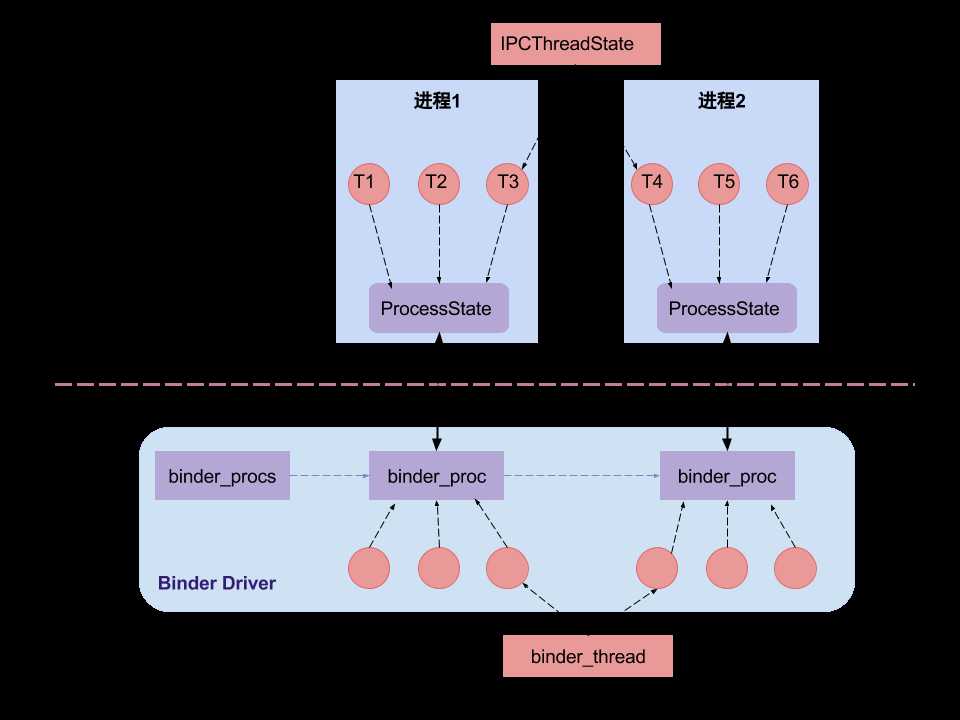标签:而且 service this dde dev image tran seq contex

ProcessState是负责打开Binder节点并做mmap映射,IPCThreadState是负责与Binder驱动进行具体的命令交互。
sp<ProcessState> ProcessState::self() { if (gProcess != NULL) return gProcess; AutoMutex _l(gProcessMutex); if (gProcess == NULL) gProcess = new ProcessState; return gProcess; }
可以看到,在这里也是先检查是否存在一个已经实例化的prosessstate,否则创建一个,所以获取ProcessState对象,需要通过这个self方法。
接下来需要一步步的观察这个新建的过程当中实现的原理。
ProcessState::ProcessState() : mDriverFD(open_driver()) , mVMStart(MAP_FAILED) , mManagesContexts(false) , mBinderContextCheckFunc(NULL) , mBinderContextUserData(NULL) , mThreadPoolStarted(false) , mThreadPoolSeq(1) { if (mDriverFD >= 0) { mVMStart = mmap(0, BINDER_VM_SIZE, PROT_READ, MAP_PRIVATE | MAP_NORESERVE, mDriverFD, 0); if (mVMStart == MAP_FAILED) { // *sigh* LOGE("Using /dev/binder failed: unable to mmap transaction memory.\n"); close(mDriverFD); mDriverFD = -1; } #else mDriverFD = -1; #endif } if (mDriverFD < 0) { // Need to run without the driver, starting our own thread pool. } }
可以看到有两个之前学习的时候了解到了,与Binder驱动紧密相关的方法:
一个是open_driver(),另一个是下面的mmap(),也就是最终打开了Binder结点以及进行了内存块的映射。
sp<IBinder> ProcessState::getContextObject(const sp<IBinder>& /*caller*/) { return getStrongProxyForHandle(0); }
ProcessState::getStrongProxyForHandle
sp<IBinder> ProcessState::getStrongProxyForHandle(int32_t handle) { sp<IBinder> result; AutoMutex _l(mLock); handle_entry* e = lookupHandleLocked(handle); if (e != NULL) { ...... IBinder* b = e->binder; if (b == NULL || !e->refs->attemptIncWeak(this)) { if (handle == 0) { ...... Parcel data; status_t status = IPCThreadState::self()->transact( 0, IBinder::PING_TRANSACTION, data, NULL, 0); if (status == DEAD_OBJECT) return NULL; } b = new BpBinder(handle); e->binder = b; if (b) e->refs = b->getWeakRefs(); result = b; } else { // This little bit of nastyness is to allow us to add a primary // reference to the remote proxy when this team doesn‘t have one // but another team is sending the handle to us. result.force_set(b); e->refs->decWeak(this); } } return result; }
ProcessState::lookupHandleLocked
ProcessState::handle_entry* ProcessState::lookupHandleLocked(int32_t handle) { const size_t N=mHandleToObject.size(); if (N <= (size_t)handle) { handle_entry e; e.binder = NULL; e.refs = NULL; status_t err = mHandleToObject.insertAt(e, N, handle+1-N); if (err < NO_ERROR) return NULL; } return &mHandleToObject.editItemAt(handle); }
从这儿看,先调用lookupHandleLocked方法,由于是第一次调用,因此新建一个handle_entry,并返回,而且其binder和refs为NULL
那么getStrongProxyForHandle方法接着往下走,由于binder为NULL,mHandle传入的是0,因此进入判断条件中,最后new BpBinder,且参数为0
因此,返回的是new BpBinder(0)
sp<IBinder> b = ProcessState::self()->getContextObject(NULL);
代码位置:/frameworks/native/libs/binder/IPCThreadState.cpp
IPCThreadState* IPCThreadState::self() { if (gHaveTLS) { //当执行完第一次之后,再次运行的时候就已经有IPCThreadState实例,只需要获取就可以使用 restart: const pthread_key_t k = gTLS; IPCThreadState* st = (IPCThreadState*)pthread_getspecific(k); if (st) return st; return new IPCThreadState; } if (gShutdown) { ALOGW("Calling IPCThreadState::self() during shutdown is dangerous, expect a crash.\n"); return NULL; } pthread_mutex_lock(&gTLSMutex); if (!gHaveTLS) { //初始的gHaveTLS的值false,所以第一次调用的时候,会执行这里的代码 //随后将gHaveTLS设置为true int key_create_value = pthread_key_create(&gTLS, threadDestructor); if (key_create_value != 0) { pthread_mutex_unlock(&gTLSMutex); ALOGW("IPCThreadState::self() unable to create TLS key, expect a crash: %s\n", strerror(key_create_value)); return NULL; } gHaveTLS = true; } pthread_mutex_unlock(&gTLSMutex); goto restart; }
通过上面的方法,就能保证“线程单实例”的目的
Binder进程与线程ProcessState以及IPCThreadState
标签:而且 service this dde dev image tran seq contex
原文地址:https://www.cnblogs.com/mingfeng002/p/10989200.html